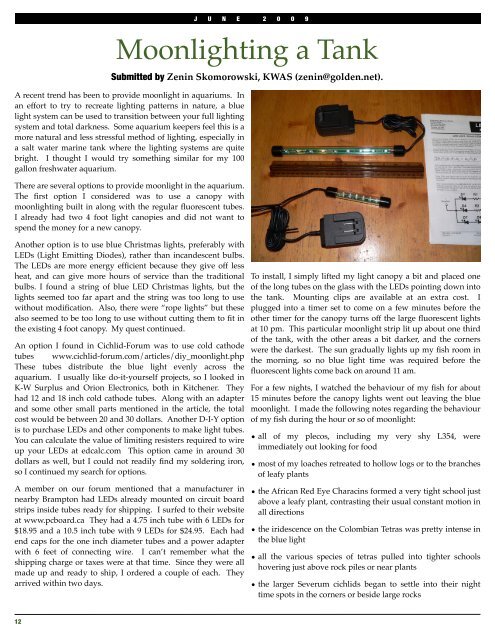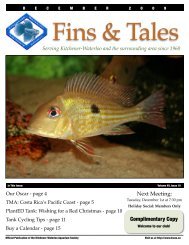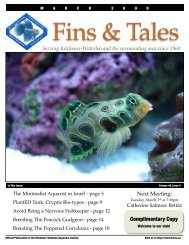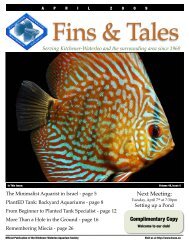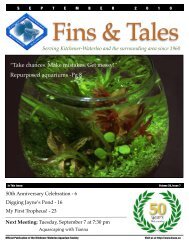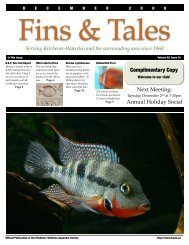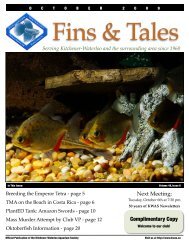June 2009 - Kitchener Waterloo Aquarium Society
June 2009 - Kitchener Waterloo Aquarium Society
June 2009 - Kitchener Waterloo Aquarium Society
Create successful ePaper yourself
Turn your PDF publications into a flip-book with our unique Google optimized e-Paper software.
A recent trend has been to provide moonlight in aquariums. In<br />
an effort to try to recreate lighting patterns in nature, a blue<br />
light system can be used to transition between your full lighting<br />
system and total darkness. Some aquarium keepers feel this is a<br />
more natural and less stressful method of lighting, especially in<br />
a salt water marine tank where the lighting systems are quite<br />
bright. I thought I would try something similar for my 100<br />
gallon freshwater aquarium.<br />
There are several options to provide moonlight in the aquarium.<br />
The first option I considered was to use a canopy with<br />
moonlighting built in along with the regular fluorescent tubes.<br />
I already had two 4 foot light canopies and did not want to<br />
spend the money for a new canopy.<br />
Another option is to use blue Christmas lights, preferably with<br />
LEDs (Light Emitting Diodes), rather than incandescent bulbs.<br />
The LEDs are more energy efficient because they give off less<br />
heat, and can give more hours of service than the traditional<br />
bulbs. I found a string of blue LED Christmas lights, but the<br />
lights seemed too far apart and the string was too long to use<br />
without modification. Also, there were “rope lights” but these<br />
also seemed to be too long to use without cutting them to fit in<br />
the existing 4 foot canopy. My quest continued.<br />
An option I found in Cichlid-Forum was to use cold cathode<br />
tubes www.cichlid-forum.com/articles/diy_moonlight.php<br />
These tubes distribute the blue light evenly across the<br />
aquarium. I usually like do-it-yourself projects, so I looked in<br />
K-W Surplus and Orion Electronics, both in <strong>Kitchener</strong>. They<br />
had 12 and 18 inch cold cathode tubes. Along with an adapter<br />
and some other small parts mentioned in the article, the total<br />
cost would be between 20 and 30 dollars. Another D-I-Y option<br />
is to purchase LEDs and other components to make light tubes.<br />
You can calculate the value of limiting resisters required to wire<br />
up your LEDs at edcalc.com This option came in around 30<br />
dollars as well, but I could not readily find my soldering iron,<br />
so I continued my search for options.<br />
A member on our forum mentioned that a manufacturer in<br />
nearby Brampton had LEDs already mounted on circuit board<br />
strips inside tubes ready for shipping. I surfed to their website<br />
at www.pcboard.ca They had a 4.75 inch tube with 6 LEDs for<br />
$18.95 and a 10.5 inch tube with 9 LEDs for $24.95. Each had<br />
end caps for the one inch diameter tubes and a power adapter<br />
with 6 feet of connecting wire. I can’t remember what the<br />
shipping charge or taxes were at that time. Since they were all<br />
made up and ready to ship, I ordered a couple of each. They<br />
arrived within two days.<br />
J U N E 2 0 0 9<br />
Moonlighting a Tank<br />
Submitted by Zenin Skomorowski, KWAS (zenin@golden.net).<br />
To install, I simply lifted my light canopy a bit and placed one<br />
of the long tubes on the glass with the LEDs pointing down into<br />
the tank. Mounting clips are available at an extra cost. I<br />
plugged into a timer set to come on a few minutes before the<br />
other timer for the canopy turns off the large fluorescent lights<br />
at 10 pm. This particular moonlight strip lit up about one third<br />
of the tank, with the other areas a bit darker, and the corners<br />
were the darkest. The sun gradually lights up my fish room in<br />
the morning, so no blue light time was required before the<br />
fluorescent lights come back on around 11 am.<br />
For a few nights, I watched the behaviour of my fish for about<br />
15 minutes before the canopy lights went out leaving the blue<br />
moonlight. I made the following notes regarding the behaviour<br />
of my fish during the hour or so of moonlight:<br />
• all of my plecos, including my very shy L354, were<br />
immediately out looking for food<br />
• most of my loaches retreated to hollow logs or to the branches<br />
of leafy plants<br />
• the African Red Eye Characins formed a very tight school just<br />
above a leafy plant, contrasting their usual constant motion in<br />
all directions<br />
• the iridescence on the Colombian Tetras was pretty intense in<br />
the blue light<br />
• all the various species of tetras pulled into tighter schools<br />
hovering just above rock piles or near plants<br />
• the larger Severum cichlids began to settle into their night<br />
time spots in the corners or beside large rocks<br />
12


